San Pedro de Atacama is a small village in the Atacama Desert located in the north of Chile. The town lies at 2.400 m above sea level and it’s the starting point for all explorations and tours in the desert. Here I’m sharing the best tours for a full 3 day itinerary for San Pedro de Atacama.
The Atacama Desert is the driest place of the world (besides the poles). It is situated between the two mountain chains the Andes and the Chilean Coast Range which prevent clouds, and consequently rain, to enter the area. Some parts of the Atacama Desert have never received rain.

This post may contain affiliate links. If you make a purchase through one of my links I will receive a small commission which helps me to maintain my site. This has no extra cost for you and you will make my day!
Due to its otherworldly landscapes the Atacama Desert has been used to film Mars scenes for movies.
Table of Contents
How to get to San Pedro de Atacama
From Santiago de Chile
The closest airport to San Pedro de Atacama is Calama. LATAM, Sky and JetSmart operate direct flights from Santiago which take two hours.
From Calama you can take a bus for about an hour and a half which drops you right in the center of San Pedro de Atacama. A round trip costs about 20 €.
Read Also:
How to spend 1 day in Santiago de Chile
From Uyuni, Bolivia
The best option to get to San Pedro de Atacama is doing the 3-4 day tour from Uyuni to San Pedro de Atacama. This tour includes a visit to the breathtaking Salar de Uyuni and allows you to explore stunning landscapes in the altiplano of Bolivia. It’s an unforgettable experience and it saves you a long bus ride.
This tour can also be done in reverse, starting in San Pedro de Atacama and ending in Uyuni.
Everything you need to know before doing this tour:
3 Day Trip from San Pedro de Atacama to the Salar de Uyuni, Bolivia

However, on this tour you’ll be in extremely high altitudes up to 4,800 m above sea level. So this might not be adequate for everyone regarding the risk of altitude sickness.
Those who don’t want do this tour have the option of taking a bus from Uyuni to San Pedro de Atacama. The companies Cruz del Norte and Trans Salvador offer daily departures from Uyuni. A ticket is between 20 and 30 € and the bus takes around 10 hours.
Getting around in San Pedro de Atacama
Once you arrived to Calama airport or San Pedro de Atacama you can either rent a car or you explore the desert by taking tours. Check out rentalcars.com to get the best deal on a rental car.
Personally, I usually always prefer renting a car and exploring places by myself. However, the desert roads can be a bit tricky to drive on and you don’t always have phone signal. This is why we decided to stay on the safe side and book tours.
Which Tour Operator to Choose
The village San Pedro is fully dedicated to tourism and on the main street you encounter one tour operator after the other. Most of them offer similar tours simply varying in prices.
We chose to book all our tours with Janaj Pacha. They offered the best price and gave us a 20% discount because we were a group of six.
Some people recommend not to book with the cheapest tour operator. This is certainly a matter of perspective and it depends on your budget. We researched the different agencies and booked the cheapest one on purpose. And we were absolutely happy with their service and had a great time on all tours.
In case you have more money to spend and feel safer with a more professional-looking agency you should book with Cosmo Andino. People say it’s the best agency in San Pedro de Atacama but expect to pay double the price for a tour.
One thing is that in the cheaper tours the guides only speak Spanish. In case you have nobody in your group who speaks Spanish it might be advisable to pay a little more and get an English speaking guide.
Check out these amazing experiences hosted by local guides:
Best time to visit San Pedro de Atacama
The best time to visit San Pedro de Atacama is between September and November or between March and May. This is the shoulder season that gets you the best of both worlds: Few tourists and good weather.
December to February is high season in San Pedro de Atacama. During this period the weather is optimal but the village is fully packed with tourists.
From June to August the temperatures are the lowest in the Atacama Desert. I was there in August and the temperatures at night and in the morning could fall below zero.
What to pack
- Warm clothes for the mornings, nights and places in high altitude. I recommend bringing thermal underwear, warm socks and a jacket to keep you warm.
- Light clothes for the days
- Swimsuit – you’ll need it for swimming in Laguna Cejar
- Sunscreen, sunglasses and a hat
- Hiking shoes – for hiking in Valle de la Luna & Valle de la Muerte. I use these ones by Colombia – they’re comfortable and they provide good stability.
- Flip flops or any type of slippers
- Lip balm with SPF
Things to know before you go
- Layering is the key to get through the days comfortably. One time I experienced -12°C in the morning and +25°C in the afternoon. Be prepared for both temperature extremes.
- Don’t rely on having a phone signal. GPS and signal don’t always work in the desert. Be prepared to be offline during your day tours.
- Bargain. Most tour agencies will give you a discount when you bargain – especially if you book several tours with them or if you’re a group.
- Souvenirs: In case you’re also going to Peru or Bolivia, buy your souvenirs there. Chile is one of the most expensive countries in South America. You will probably find the same souvenirs in Peru or Bolivia but for half of the price.
- Do the tour to the highest altitude at the end. San Pedro is located at 2,400 m above sea level and some sights in the Atacama Desert are even higher. To avoid altitude sickness I recommend doing the Geysers el Tatio (4,320 m) on your last day. This helps your body to adjust to the lower amount of oxygen in the air.
- You’ll be in extremely high altitudes. Make sure to protect your skin from the sun and to stay hydrated. Even though it might not feel so hot, the skin burns more easily in these altitudes.
- Stargazing is a must in everyone’s San Pedro de Atacama itinerary. Try to schedule your trip in a way that you avoid full moon. The best time to observe the sky is when it’s completely dark. Full moon lights up the sky and makes the stars and galaxies less visible.

Where to stay in San Pedro de Atacama
The main street of San Pedro de Atacama is “Caracoles”. It’s best to have an accommodation that is close to this street as all the agencies, restaurants and shops are there.
Budget
Hostal Rural: 12 € per night for one bed in a dorm room incl. breakfast
Hostal Rural is often referred to as the best hostel of San Pedro de Atacama. I stayed there myself and I loved it. It’s a great place for backpackers to meet fellow travellers.
Mid budget
Hotel Kimal: 85 € per night for a private room incl. breakfast (price for two persons)
Luxury
Hotel Cumbres San Pedro: 240 € per night for for a private room incl. breakfast (price for two persons)
The Perfect 3 Day Itinerary for San Pedro de Atacama
| Morning | Afternoon/Evening | |||
| Day 1 | Piedras Rojas, Laguna Chaxa |
Stargazing | ||
| Day 2 | Valle de la Muerte | Laguna Cejar, Ojos del Salar, Laguna Tebinquiche |
||
| Day 3 | Geysers el Tatio | Valle de la Luna |
This itinerary for San Pedro de Atacama allows you to see the best of the Atacama Desert within 3 days. However, if you have more time I suggest spending one or two more days there because there’s much to see and do.
Day 1
Piedras Rojas & Laguna Chaxa
For the tour to Piedras Rojas (engl.: red rocks) we were picked up at 6:00 am in our hostel. It was freezing outside. Getting to Piedras Rojas took around an hour of driving up curvy mountain roads. All of a sudden my head started aching and I felt a bit sick in my stomach. At first I didn’t understand why until I finally realised that it was because of the altitude. Piedras Rojas is elevated 4,000 m above sea level and I had never been in such high altitudes before. Symptoms of altitude sickness are common in the Atacama Desert and they can include headache, dizziness, stomach sickness or palpitation. It’s important to stay hydrated and take it easy, that means move slowly and don’t go up too high on your first days there.
UPDATE: Since 2018 tourists are not allowed to walk on the rocks anymore. Access is granted to a view point from which you can see the red rocks and the lagoon.


When we arrived to Piedras Rojas the temperature was -6°C degrees and we were surrounded by snow capped mountains. First we had breakfast outside in the cold. Our guide prepared avocado, cheese, bread, jam, yoghurt, cookies, juice and coffee or tea for us.
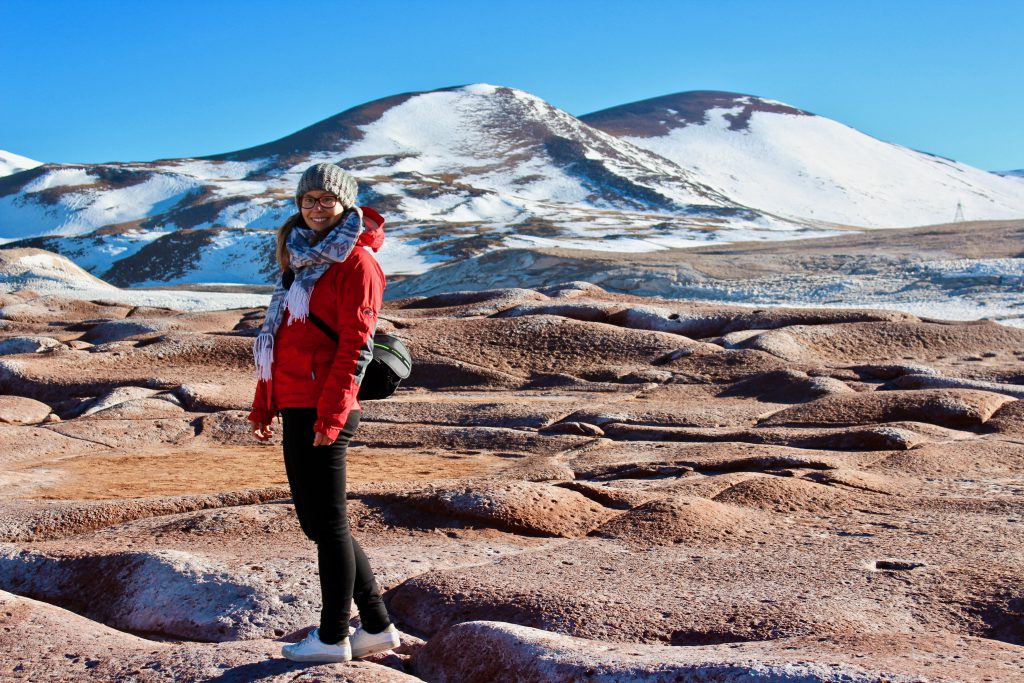

Even though it was freezing cold we enjoyed the view and the tranquility of being the only ones there. Having breakfast with my friends in this beautiful landscape made me forget the cold for a while.


After breakfast we walked around and explored the area for a bit. But every step became more exhausting than the previous one and I was breathing as if I had just finished a marathon. Moving in these altitudes is no joke. We took some photos and hopped onto the van to continue our tour.
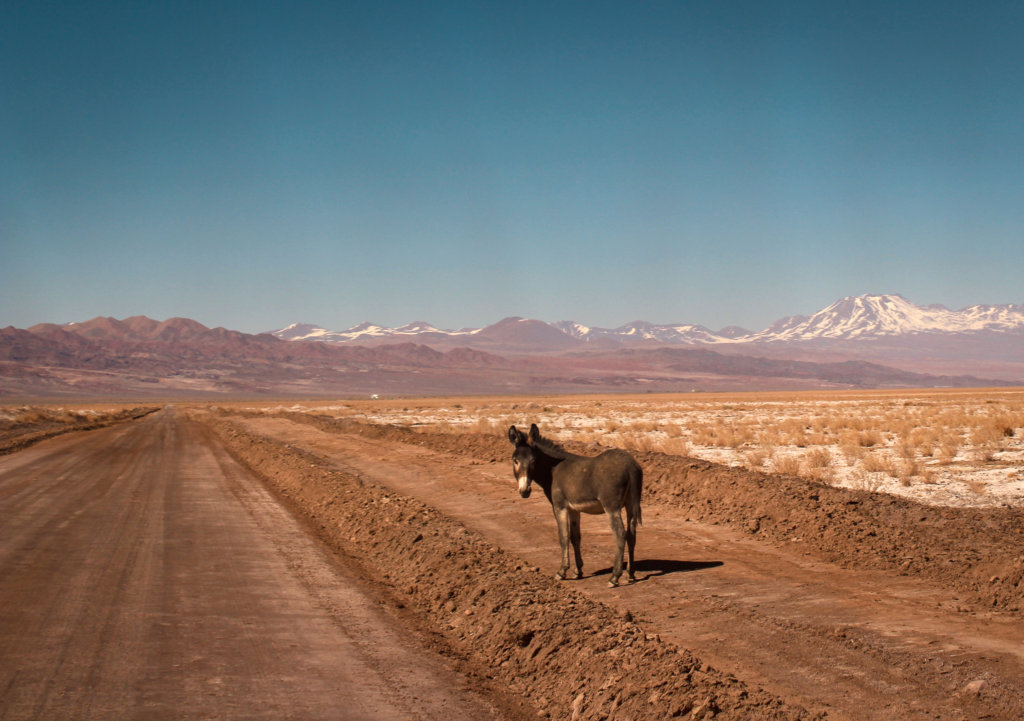

Driving through the desert we encountered this cute donkey on the side of the road.
Our next stop was Laguna Chaxa which is part of the National Reserve Los Flamencos. Laguna Chaxa is considered one of Chile’s best places to see flamingos in their natural habitant.
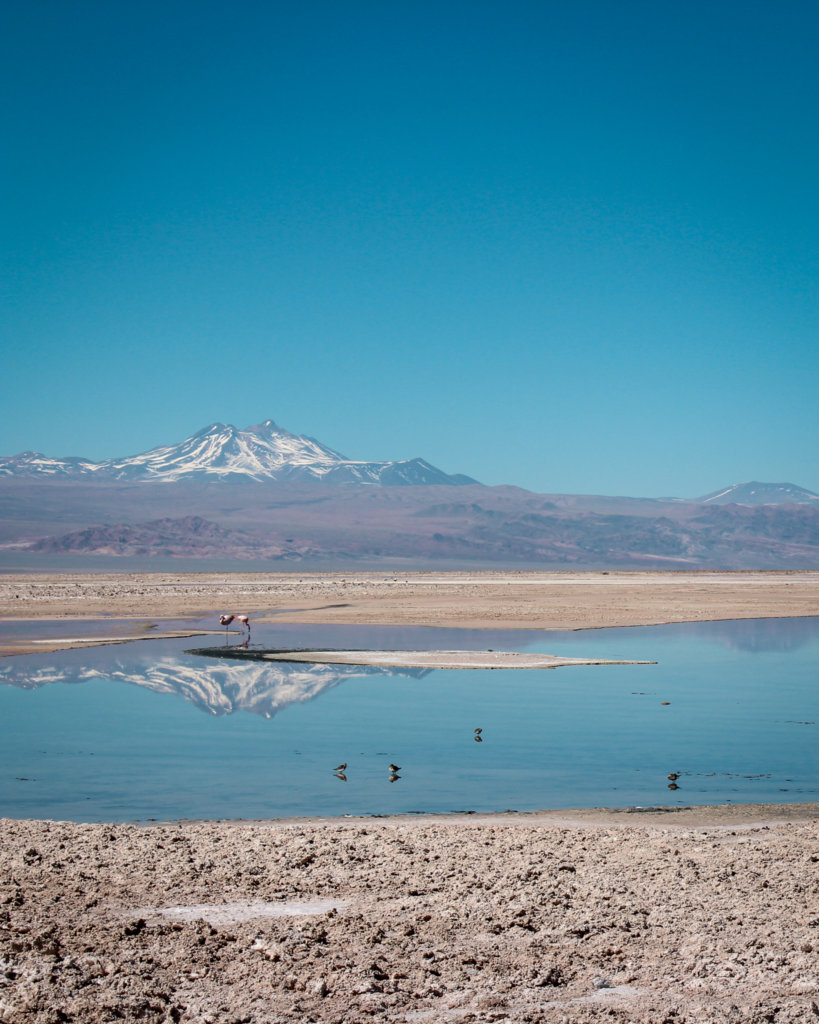

When we got there it was already noon and the temperature was much more agreeable.
Finally we got so see the flamingos – that’s what I was most excited for.
And the landscape is breathtaking. Lakes with crystal clear water reflect the snowy mountains. This tour is a must for nature lovers.
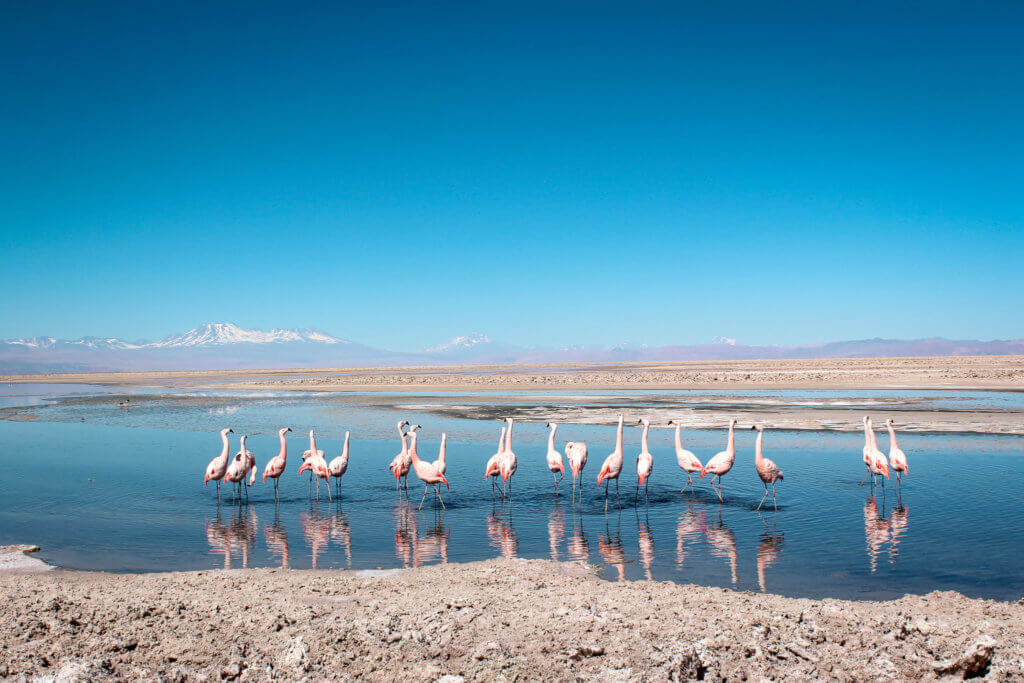

After staying at Laguna Chaxa for a while to admire the stunning scenery we made our way back to San Pedro de Atacama. Tired from getting up early we used the remaining afternoon to relax in our hostel. After all we had another tour ahead of us this day.
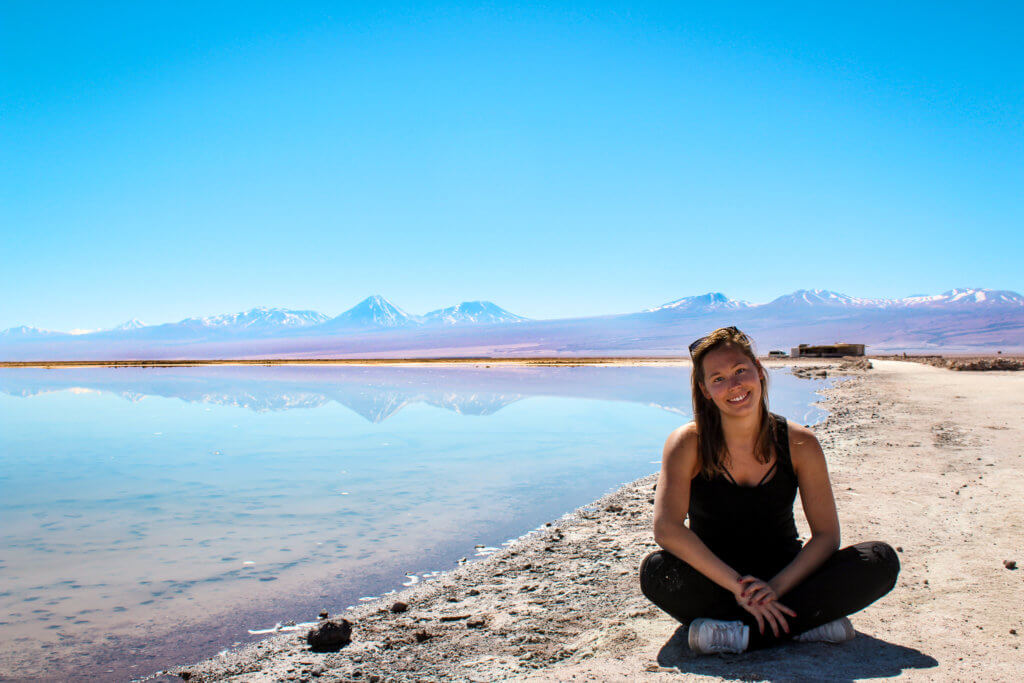

Stargazing
This night we had an exciting tour planned: Stargazing in the desert. Thanks to the altitude and the lack of light pollution San Pedro is one of the best places worldwide to do stargazing. The majority of the world’s observatories are located there.
At around 10 pm we were picked up from our hostel and brought to the outskirts of the village. Hopping out of the van I couldn’t believe my eyes. I had never seen a starry sky like this before, it was incredible.
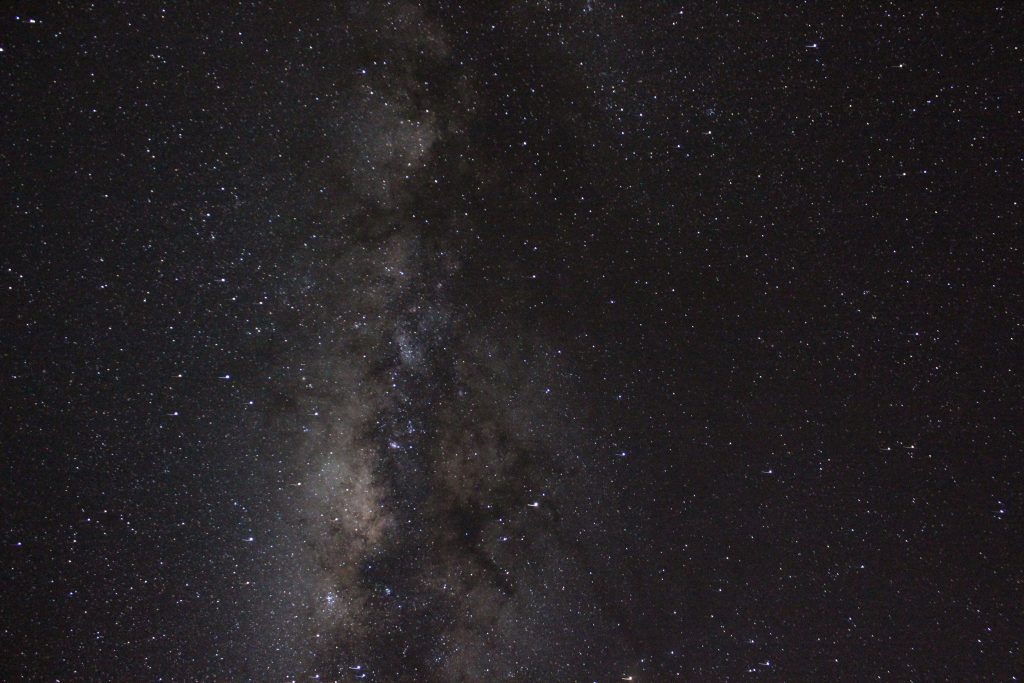

We were a group of 8 and our guides set up two telescopes. They explained us a lot about planets and constellations.
Taking turns looking through the telescope we observed the night sky. We could even spot the planet Saturn with its ring. This was such an epic experience.
The guides took photos of us and they knew exactly how to set my camera for the night sky. I had no idea that my Canon EOS 1300D was able to take such photos as the one above so I was quite impressed when I saw the result.
Temperatures were really low though and to keep us from freezing our guides prepared tea, hot chocolate and some snacks for us.
Looking up to the sky and seeing this seemingly endless universe with billions of stars makes you feel so small. It was one of those moments that leave you speechless and stay in your mind forever. This was the most impressive night sky I had ever seen.
Day 2
Valle de la Muerte
On the second morning we headed out to explore San Pedro de Atacama by ourselves. We passed by a bike rental agency and decided to rent bikes and get active. The owner of the shop was very helpful and suggested several places we could explore by bike. Finally, we agreed on biking to Valle de la Muerte (engl.: Death Valley).
Only about twenty minutes outside of the center of San Pedro de Atacama we arrived to the entrance of Valle de la Muerte. There’s an entrance fee of around 3 €. The ranger said we could just follow the path by bike as long as we could. If it gets to sandy we’d have to push the bikes.


It was truly exhausting to bike there. Besides the heat and the sandy ground we were also at 2,400 m above sea level. The lower level of oxygen in the air urges you to breath faster and makes you feel exhausted.
After biking through a canyon for ten minutes we had to get off the bikes as the ground got too sandy. We locked the bikes on the side of the road and left them there. From then on the path went uphill and we started hiking the remaining part up to the peak.


The views from the peak of Valle de la Muerte were beyond stunning: Snow capped mountains in the far distance, sand dunes on the left and a Mars-like landscape right ahead.
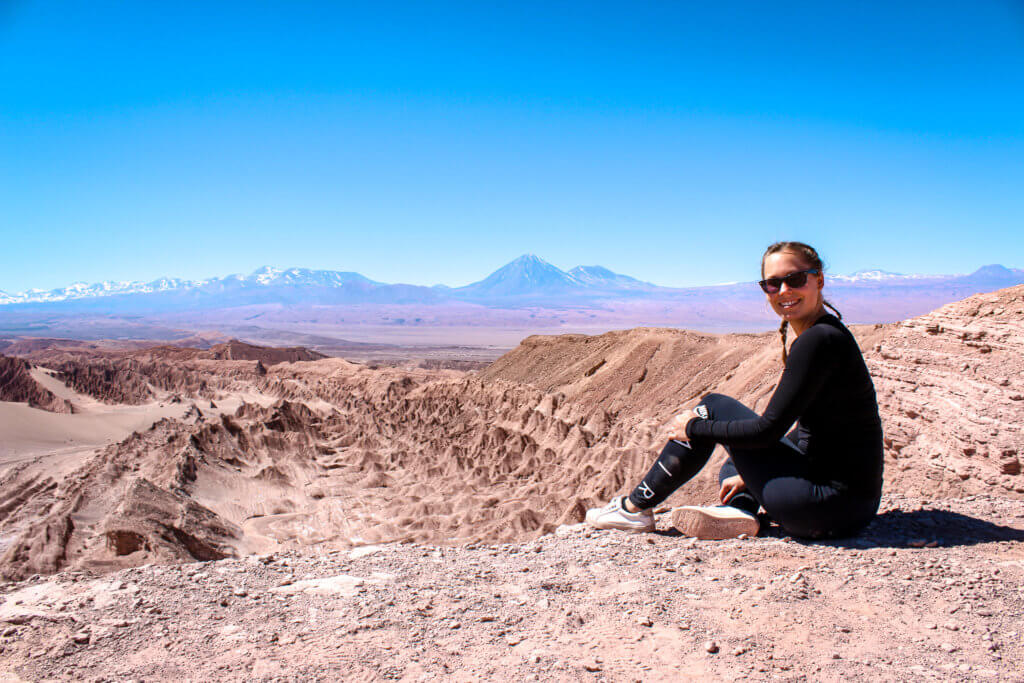

This was my personal highlight of the San Pedro de Atacama itinerary. It combined being active and going off the beaten track to explore a place without taking part in a tour. The best part was that there where no other people at all.
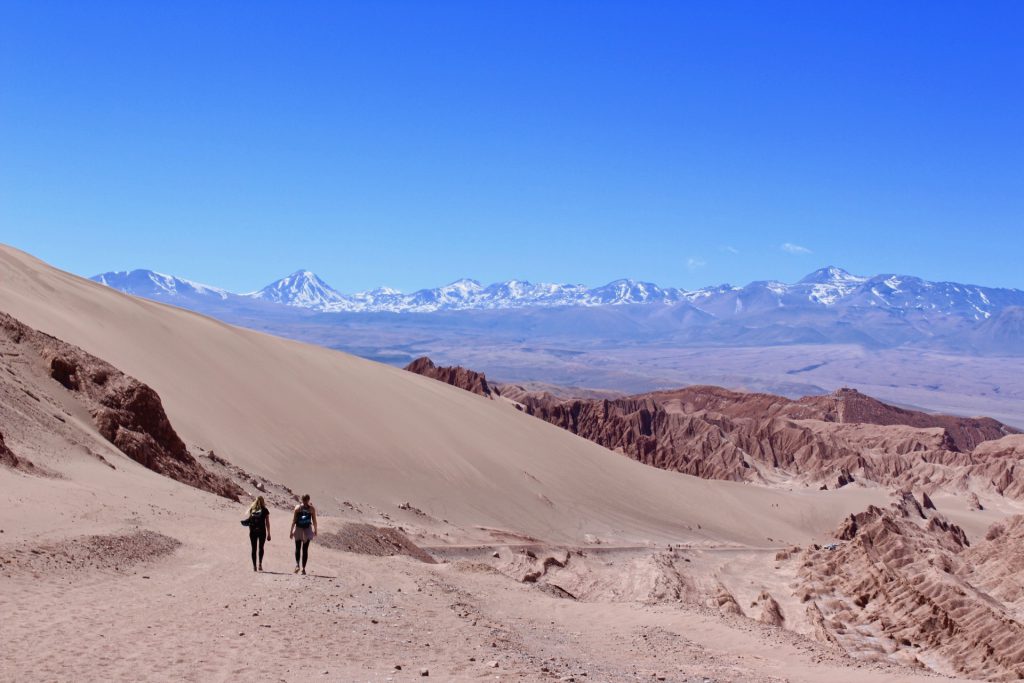

You can even do sand boarding in Valle de la Muerte. People were boarding down the sand dune on the left side of the photo above. There’s a small shelter next to it where you can rent a sand board.
After staying on the highest point of the valley for a while to enjoy the view we hiked down to our bikes and biked back to San Pedro de Atacama. We returned our bikes and headed to the hostel where we were soon picked up for our second trip this day.
Desert Lagoons
On our afternoon tour we visited Laguna Cejar, Ojos del Salar and Laguna Tebinquiche, which are some of Atacama’s desert lagoons.
Laguna Cejar is a salt water lake surrounded by an incredible landscape. The turquoise water and the white salt paired with the blue sky and reddish hills compose a view like nowhere else.
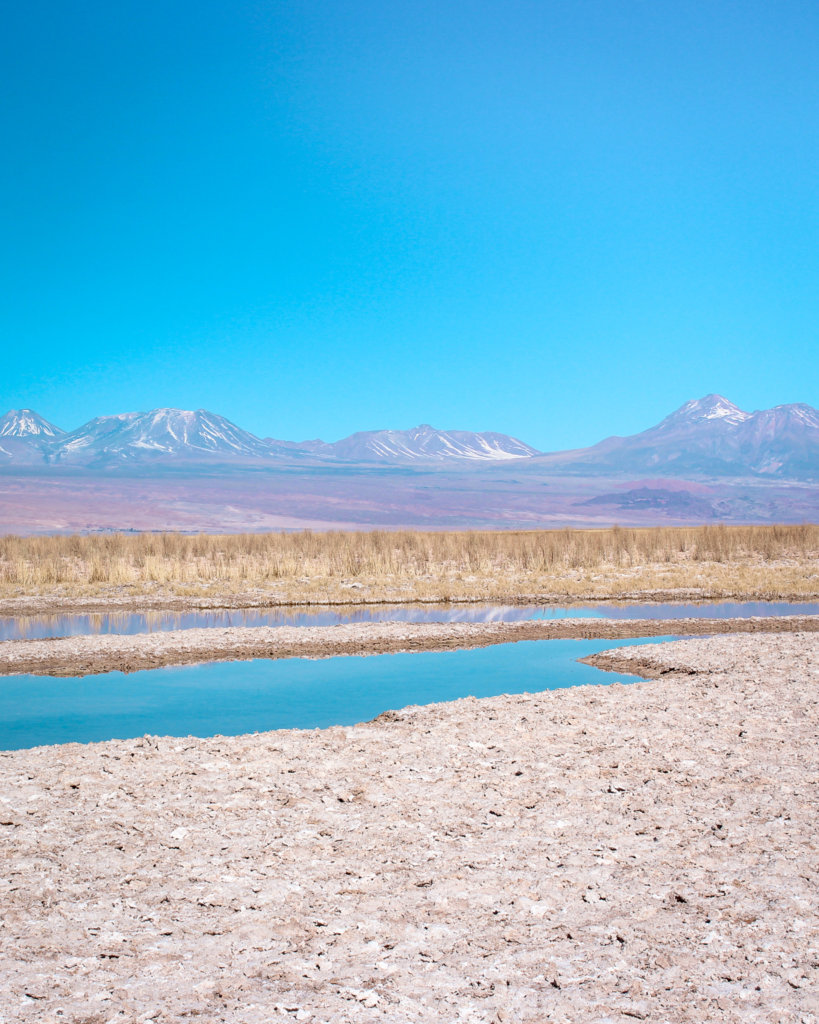

To enter the area of Laguna Cejar you have to pay a fee of 15 €. There are changing rooms and bathrooms available and you can even go swimming in the lagoon. There’s so much salt in the water that you can float without sinking.



After around half an hour of enjoying the view and floating in the ice cold water (we were there in winter) we had to go back to the van to head to our next stop: Ojos del Salar, two fresh water lagoons in the middle of nowhere.


You can even go swimming in one of them but as we were there in winter it was too fresh for us to jump in.


The lagoons are so deep and the water is so clear that they show a perfect reflection of the person standing in front of them.
Then we continued the journey to Laguna Tebinquiche, yet another desert lake with a stunning scenery. We watched the sunset there and our guide prepared some drinks and snacks for us.


The golden hour put a beautiful orange light on the lake and on the mountains. We enjoyed the view with a drink and some snacks while the sun was going down.


As soon as the sun had set it got colder immediately. We hopped onto the van and made our way back to San Pedro de Atacama.
Day 3
Geysers del Tatio
On day 3 it was time to go up to the highest point of our itinerary: The Geysers del Tatio at 4,320 m above sea level. They are the highest geysers in the world.
Our guide told us that it’s best to go early in the morning to see the geysers when they’re most active. We got up at 5:00 am, were picked up from the hostel shortly after and drove uphill towards the geysers.
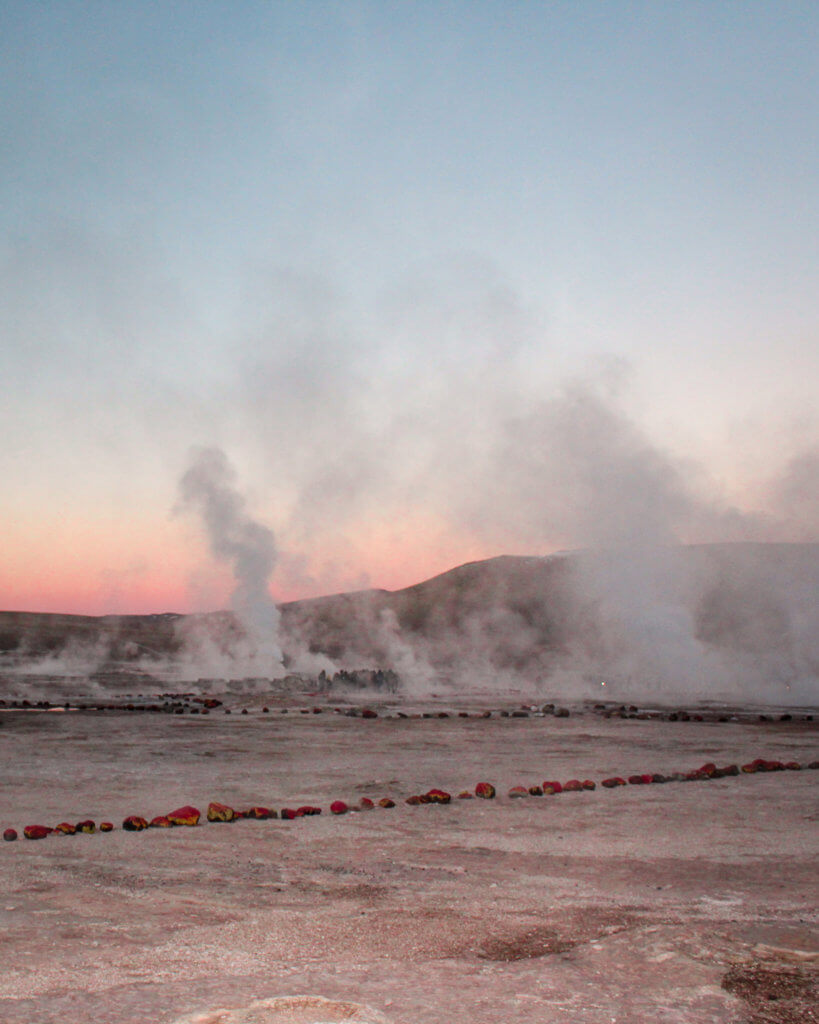

When we arrived, the sun hasn’t even risen yet and the cold was way worse than what we had imagined. It had -12°C degrees and our outfits made it almost unbearable to be outside.
I didn’t even want to leave the van. But then again, I could see this place once in a lifetime, so I overcame my instincts and got off.
First we had breakfast – yes, outside – and then we walked along marked paths through the geyser field. Our guide told us that once a tourist fell into a geyser and died. That was scary enough to keep us far away from the steam holes.
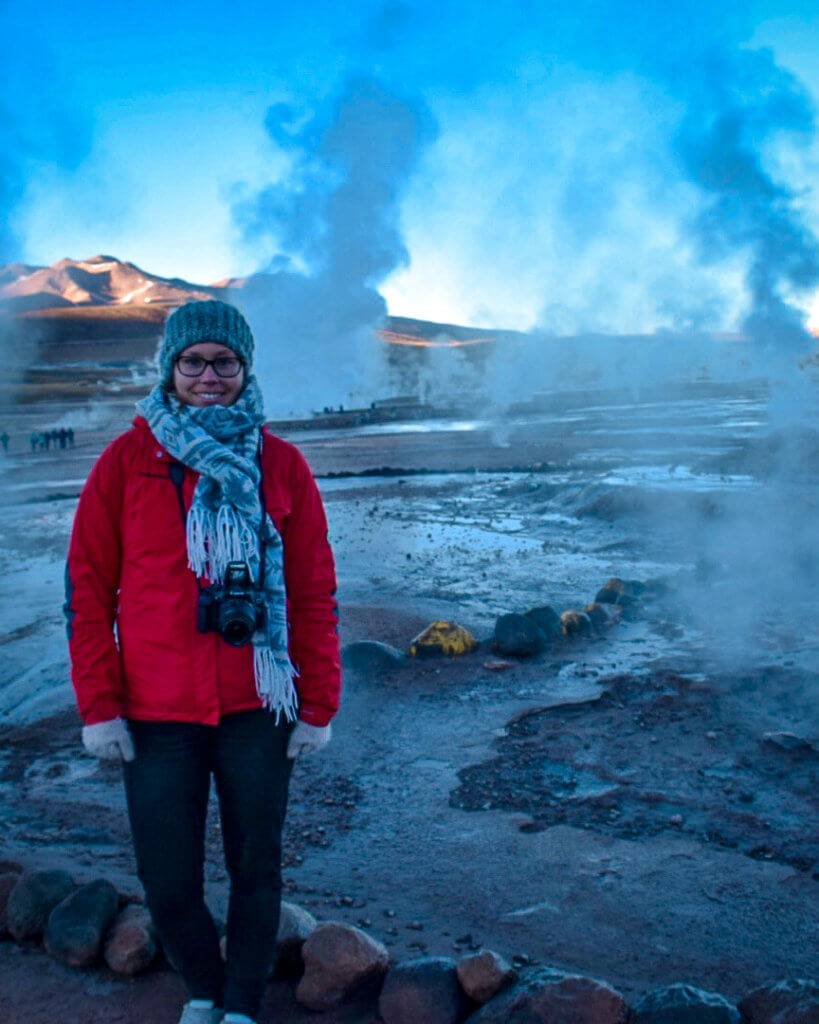

At first my extremities hurt because of the cold and after a while I didn’t feel my feet anymore. I have to admit it was my fault – I didn’t bring any warm clothes to San Pedro de Atacama. So I had to make the best out of what I had: several layers of shirts with a windbreaker, two layers of pants and my sneakers.
I can tell you I had never felt this cold before, I’m not kidding.
Make sure to bring enough warm clothes when you go there! Especially if you go in winter (June-September).
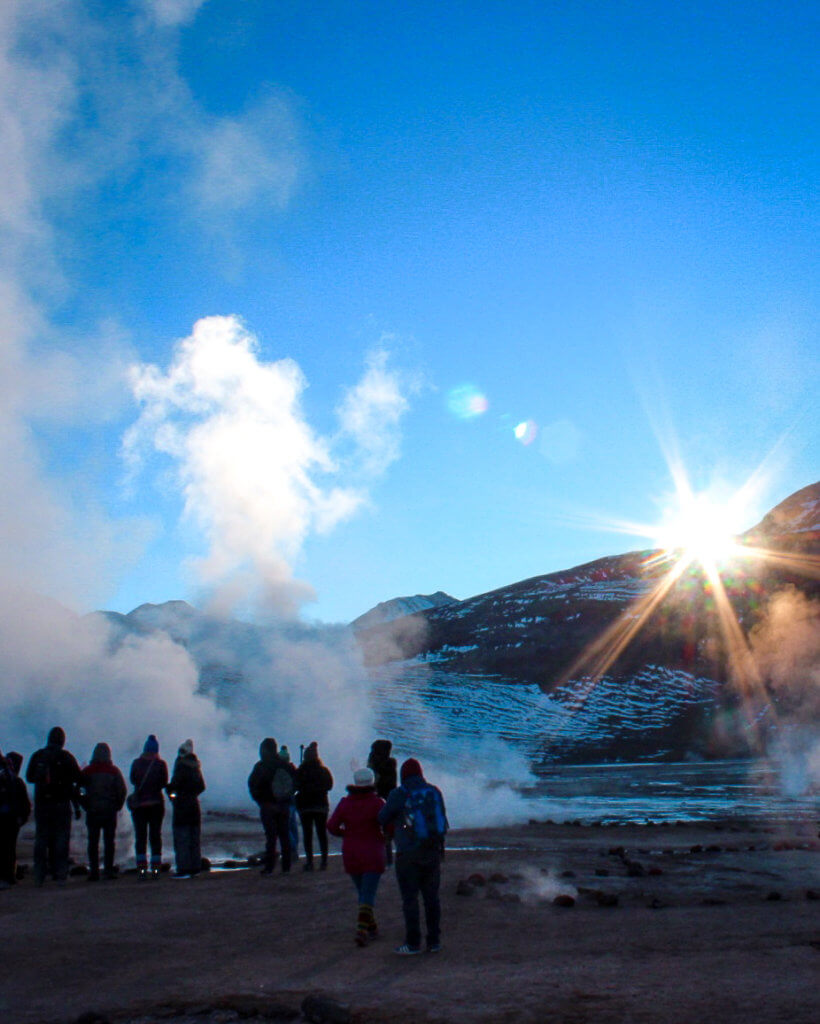

And then the relieving moment: The sun finally had finally risen above the hill and the first sun rays touched my (almost) frozen skin. Even though it was still freezing it felt so much warmer immediately.


Enjoying the warmth of the sun we stayed in the geyser field and watched the geysers erupt.
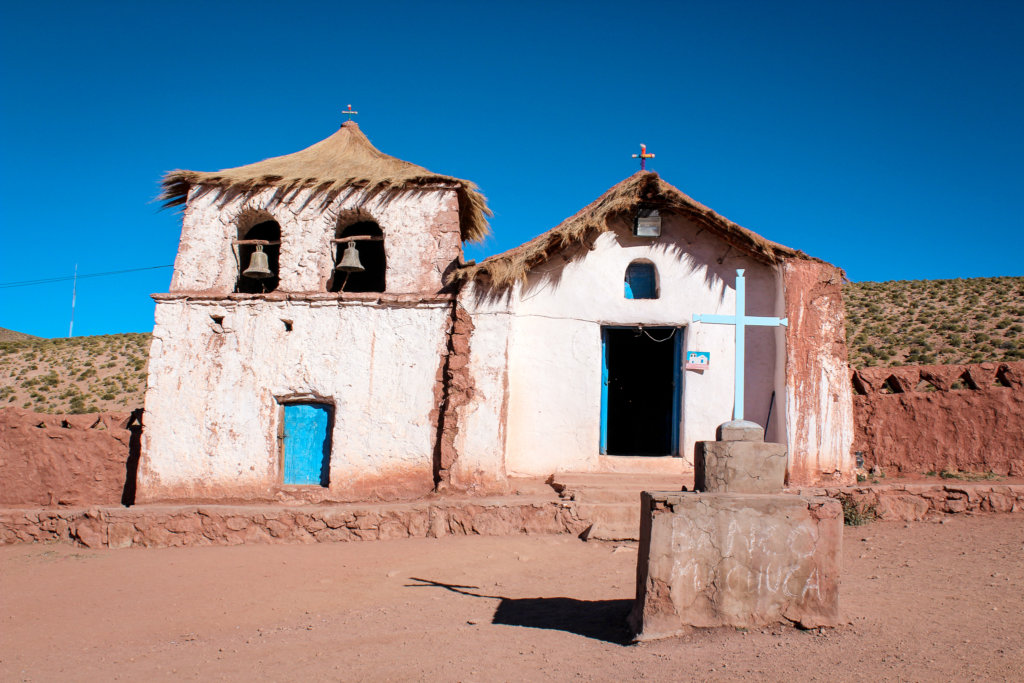

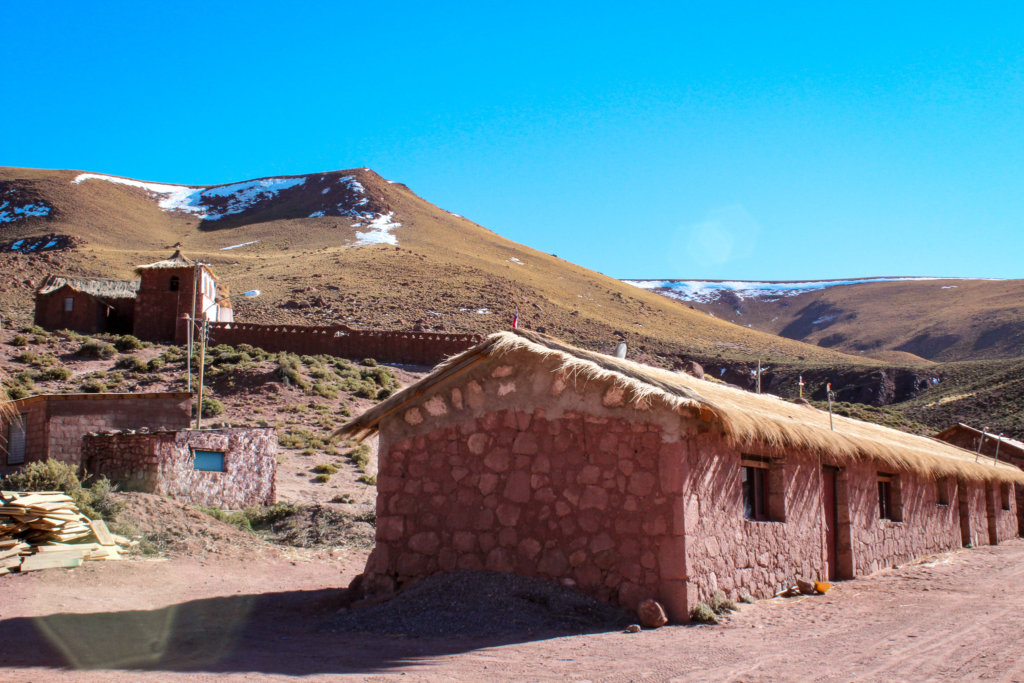

On the way back we stopped in the small desert village Machuca. It consists of only a few clay houses and a tiny church.
After a short stop in Machuca we headed back to San Pedro de Atacama and we relaxed for a bit before we were picked up for our next tour already: A trip to the Valle de la Luna (engl.: Moon Valley).
Valle de la Luna
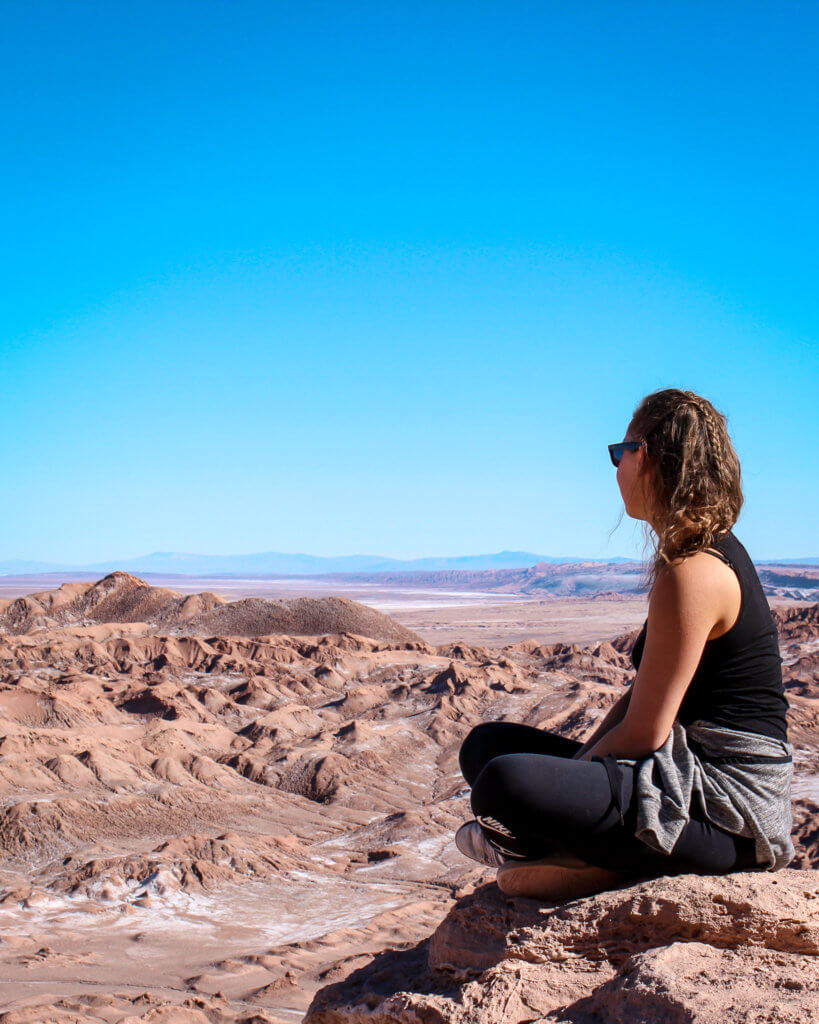

The Valle de la Luna is home to rock formations that were formed by the influence of wind and sand. It has its name because of its strange lunar landscape which seems like out of this world. The white spots on the photo above are layers of salt.
We drove through the valley and stopped at several sites to get out of the van and admire the scenery.
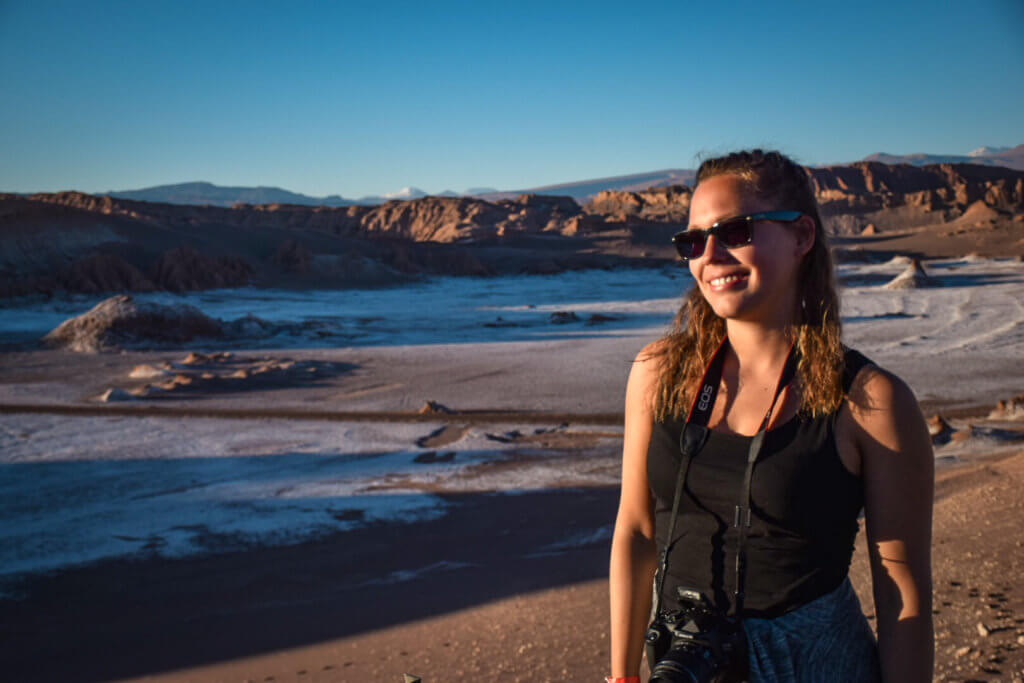

Later we hiked up a big sand dune to watch the sunset from there. The light of the golden hour made the sand dune shine orangey while the sun was setting behind a hill. It was a magical moment.
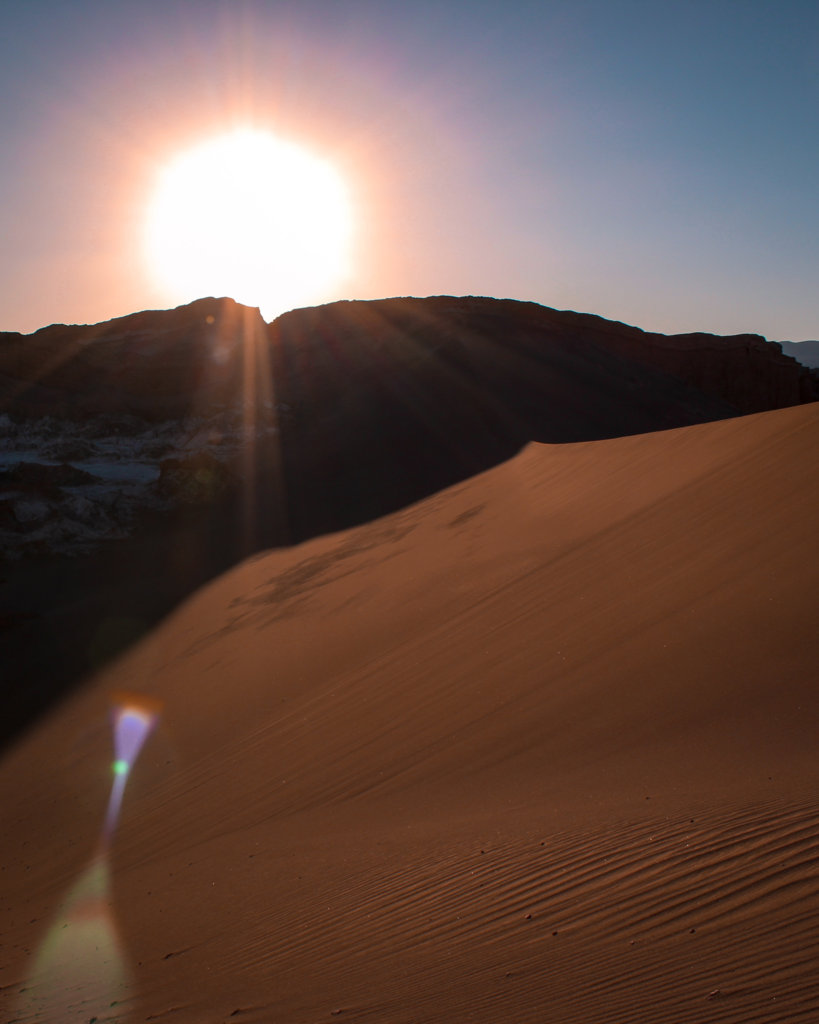

Never would I have imagined that a desert could be that impressive. The nature is beautiful and like nowhere else. The mountains, the lakes, the wildly roaming animals and the Mars-like landscapes make the Atacama Desert unique and definitely worth a visit. There are so many different activities to do and places to discover.
This 3 day itinerary for San Pedro de Atacama allows you to see the top sights in a composed time. If you can, I suggest staying longer. Especially the tour to the Salar de Uyuni is an absolute must which you shouldn’t miss.
Coffee is the fuel that keeps me running. I put a lot of time and effort into creating blog posts to make travel planning easier for you. If you benefited from my blog, I would appreciate a cup of coffee! 🙂
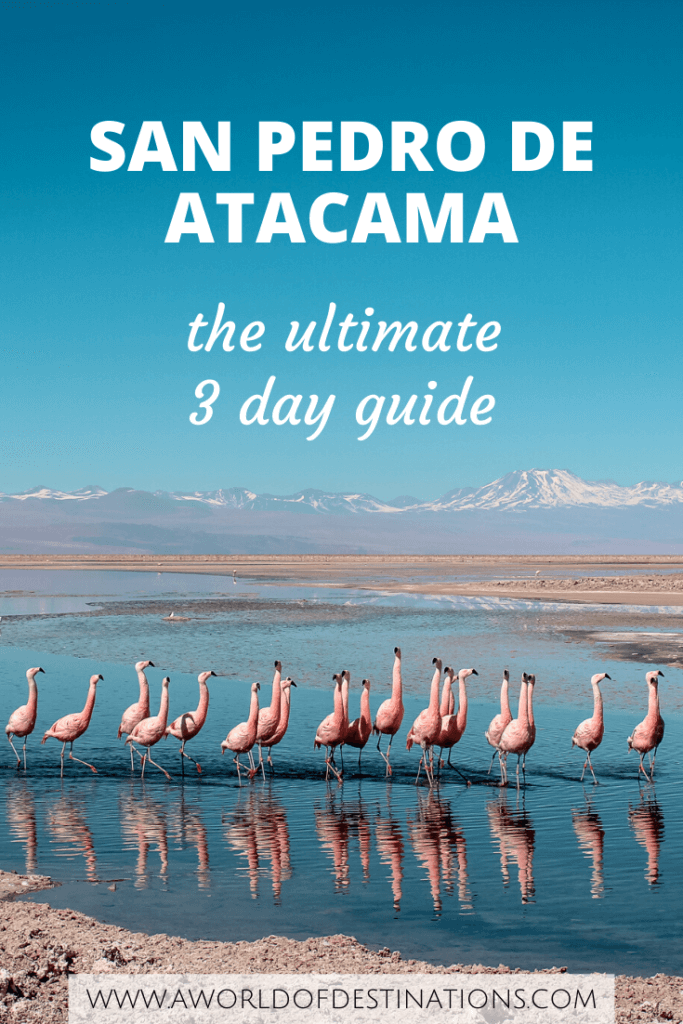

Sharing is caring!
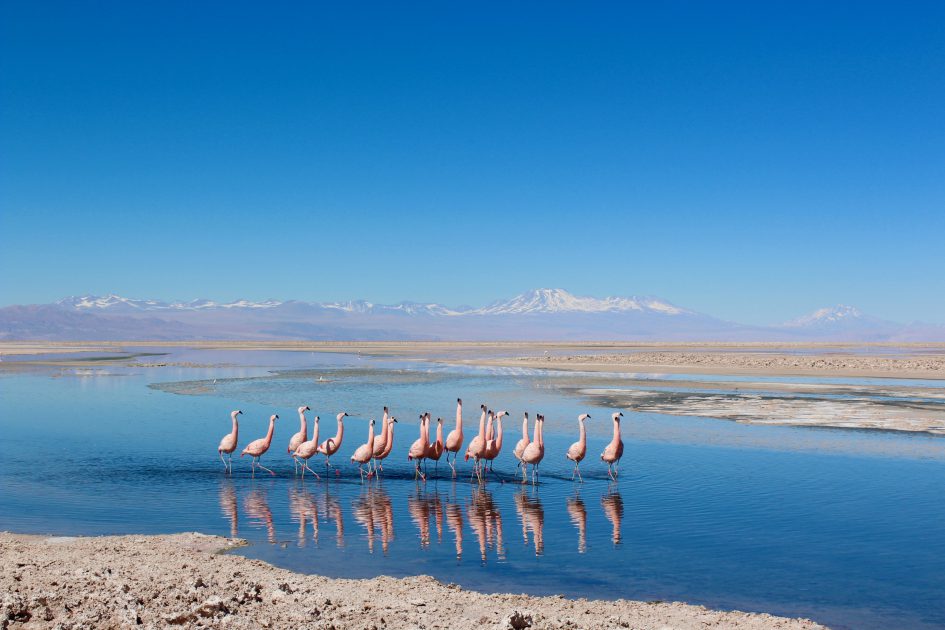

April 11, 2020 at 10:31 pm
San Pedro de Atacama looks absolutely amazing and your photos are beautiful! Those geysers are so cool. I’m hoping to do this trip in 2021. I will definitely keep this handy! 🙂
April 11, 2020 at 10:55 pm
Thank you Taylor, I’m sure you’d love it. It’s such a stunning place to explore!
April 13, 2020 at 3:36 am
I loved reading your itinerary!! I would love to do this trip one day!
April 13, 2020 at 9:20 pm
Thank you Katherine! I hope you get the chance to do it!
April 13, 2020 at 4:36 pm
Kicking myself for not going to San Pedro de Atacama when I visited Chile in 2017! Something I’ll note for the next time I visit! Lovely photography xx
April 13, 2020 at 9:23 pm
Yess definitely go there next time! Thanks Sarah!
April 14, 2020 at 5:35 pm
Omg wow this place looks truly incredible Maria! I’d love to visit it 😍
April 14, 2020 at 11:28 pm
The Atacama Desert has so many stunning places to explore. I hope you get to visit it someday!
April 17, 2020 at 12:35 pm
This is a great post! I didn’t know there are some many gems in Chile 🙂 It’s definitely somewhere I would love to visit.
April 17, 2020 at 12:47 pm
Chile is full of stunning landscapes and hidden gems. The country is certainly worth visiting 🙂
February 13, 2021 at 9:48 pm
Wandering in this desert must be an amazing experience! I am blown away by your photos and the landscapes there! Thanks for sharing all your tips!
February 15, 2021 at 3:33 pm
It really is an amazing experience! The landscapes are otherworldly
February 13, 2021 at 10:55 pm
this is such an in-depth guide!! I really want to visit, your photos are stunning. Looks like a beautiful place!
February 15, 2021 at 3:32 pm
Thank you! It really is a stunning place!
February 13, 2021 at 11:33 pm
Great article! I visited Uyuni and southern Bolivia and LOVED it, but I never made it to the Chilean side of the border here. Thanks for sharing!
February 15, 2021 at 3:32 pm
Thank you! Uyuni is one of the most impressive places I’ve visited in my life!
May 14, 2022 at 10:38 pm
What tour company did you use? I am going w my mom in June!
May 24, 2022 at 10:17 pm
The company that I used back in 2017 was Janaj Pacha. But lately, their reviews have been quite bad and I’m not even sure if the agency still exists. It might be better to check there for a different tour company 🙂